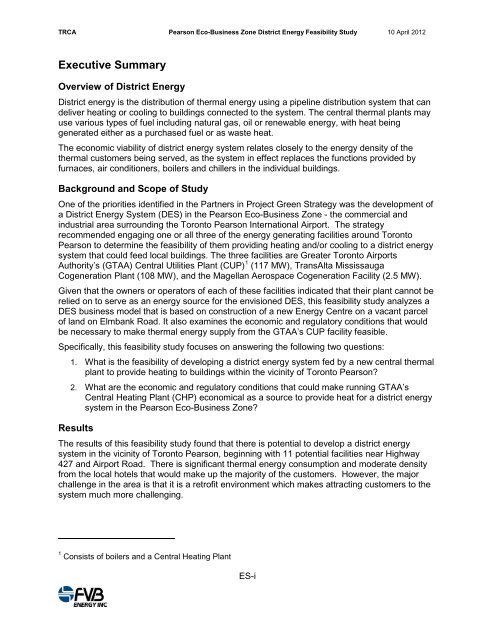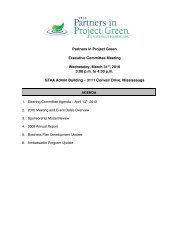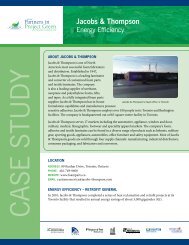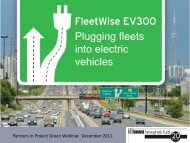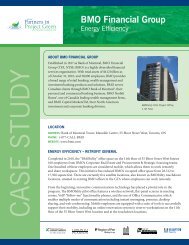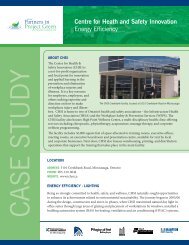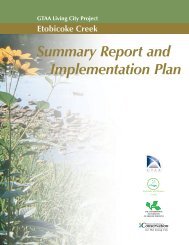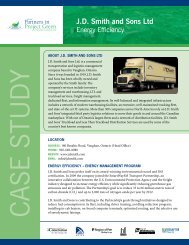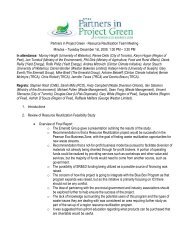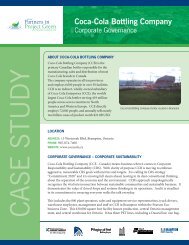Project Green District Energy Feasibility Study - Partners in Project ...
Project Green District Energy Feasibility Study - Partners in Project ...
Project Green District Energy Feasibility Study - Partners in Project ...
You also want an ePaper? Increase the reach of your titles
YUMPU automatically turns print PDFs into web optimized ePapers that Google loves.
TRCA Pearson Eco-Bus<strong>in</strong>ess Zone <strong>District</strong> <strong>Energy</strong> <strong>Feasibility</strong> <strong>Study</strong> 10 April 2012<br />
Executive Summary<br />
Overview of <strong>District</strong> <strong>Energy</strong><br />
<strong>District</strong> energy is the distribution of thermal energy us<strong>in</strong>g a pipel<strong>in</strong>e distribution system that can<br />
deliver heat<strong>in</strong>g or cool<strong>in</strong>g to build<strong>in</strong>gs connected to the system. The central thermal plants may<br />
use various types of fuel <strong>in</strong>clud<strong>in</strong>g natural gas, oil or renewable energy, with heat be<strong>in</strong>g<br />
generated either as a purchased fuel or as waste heat.<br />
The economic viability of district energy system relates closely to the energy density of the<br />
thermal customers be<strong>in</strong>g served, as the system <strong>in</strong> effect replaces the functions provided by<br />
furnaces, air conditioners, boilers and chillers <strong>in</strong> the <strong>in</strong>dividual build<strong>in</strong>gs.<br />
Background and Scope of <strong>Study</strong><br />
One of the priorities identified <strong>in</strong> the <strong>Partners</strong> <strong>in</strong> <strong>Project</strong> <strong>Green</strong> Strategy was the development of<br />
a <strong>District</strong> <strong>Energy</strong> System (DES) <strong>in</strong> the Pearson Eco-Bus<strong>in</strong>ess Zone - the commercial and<br />
<strong>in</strong>dustrial area surround<strong>in</strong>g the Toronto Pearson International Airport. The strategy<br />
recommended engag<strong>in</strong>g one or all three of the energy generat<strong>in</strong>g facilities around Toronto<br />
Pearson to determ<strong>in</strong>e the feasibility of them provid<strong>in</strong>g heat<strong>in</strong>g and/or cool<strong>in</strong>g to a district energy<br />
system that could feed local build<strong>in</strong>gs. The three facilities are Greater Toronto Airports<br />
Authority’s (GTAA) Central Utilities Plant (CUP) 1<br />
(117 MW), TransAlta Mississauga<br />
Cogeneration Plant (108 MW), and the Magellan Aerospace Cogeneration Facility (2.5 MW).<br />
Given that the owners or operators of each of these facilities <strong>in</strong>dicated that their plant cannot be<br />
relied on to serve as an energy source for the envisioned DES, this feasibility study analyzes a<br />
DES bus<strong>in</strong>ess model that is based on construction of a new <strong>Energy</strong> Centre on a vacant parcel<br />
of land on Elmbank Road. It also exam<strong>in</strong>es the economic and regulatory conditions that would<br />
be necessary to make thermal energy supply from the GTAA’s CUP facility feasible.<br />
Specifically, this feasibility study focuses on answer<strong>in</strong>g the follow<strong>in</strong>g two questions:<br />
1. What is the feasibility of develop<strong>in</strong>g a district energy system fed by a new central thermal<br />
plant to provide heat<strong>in</strong>g to build<strong>in</strong>gs with<strong>in</strong> the vic<strong>in</strong>ity of Toronto Pearson?<br />
2. What are the economic and regulatory conditions that could make runn<strong>in</strong>g GTAA’s<br />
Central Heat<strong>in</strong>g Plant (CHP) economical as a source to provide heat for a district energy<br />
system <strong>in</strong> the Pearson Eco-Bus<strong>in</strong>ess Zone?<br />
Results<br />
The results of this feasibility study found that there is potential to develop a district energy<br />
system <strong>in</strong> the vic<strong>in</strong>ity of Toronto Pearson, beg<strong>in</strong>n<strong>in</strong>g with 11 potential facilities near Highway<br />
427 and Airport Road. There is significant thermal energy consumption and moderate density<br />
from the local hotels that would make up the majority of the customers. However, the major<br />
challenge <strong>in</strong> the area is that it is a retrofit environment which makes attract<strong>in</strong>g customers to the<br />
system much more challeng<strong>in</strong>g.<br />
1 Consists of boilers and a Central Heat<strong>in</strong>g Plant<br />
ES-i


